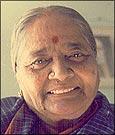 | « Back to article | Print this article |

My family knew Pattammal from 1937-38, even before I was born. Because my parents were patrons of music and musicians, she became a very good friend of my mother (Alamelu Viswanathan). When Pattammal visited her at home once, she presented her with a very simple sari and Pattammal was so happy that she wore that for her next concert.
When my eldest sister acted in a film called Thyagabhoomi made by my uncle K Subrahmanyam as Baby Saroja, they wanted D K Pattammal to sing some of the songs. The film was based on a story by the famous writer Kalki Krishnamurthy, and the theme was very modern and had patriotic undercurrents.
Pattammal agreed, and that was the first time she sang in a film. It was a very bold decision for her as she came from an orthodox Brahmin family. She was also only in the beginning of her career as a Carnatic singer then. Her father was very sceptical initially about singing in films but as they were all classical tunes tuned by Papanasam Sivan, he agreed. Those records became very popular.
When we grew up and saw the film, we understood why the songs became so popular. She had brought a lot of spirit and soul to the songs.
Pattammal came from Kanchipuram to Chennai (then Madras) and her father encouraged her to give concerts, and that itself was quite revolutionary in those days. It was unheard of for a Brahmin woman to sit on stage in front of hundreds of people and sing. It was her school teacher who urged her to go to Madras and get more training in Carnatic music. She was singing more of patriotic songs then which she had learnt from her father. Once in Madras, she started learning from a guru and giving concerts. She was the first Brahmin woman in Tamil Nadu to give kacheris (concerts) on stage.
Semmangudi Srinivasa Iyer always used to acknowledge her as a pioneer in Carnatic music. She literally stormed the male bastion, and became a solid singer of classical music.
My first image of her was of a lady who looked very simple, like a housewife, in a Kanchipuram sari and shining diamond ear-rings. Her big diamond ear-rings were quite famous then. She sang a lot of Tamil compositions. I remember her singing some very interesting raagam thaalam pallavi which women were not even expected to sing. That was because it was very complicated. She could sing in many thaalams.
I also remember some of her fabulous concerts where she used to be accompanied by her brother D K Jayaraman. The uniqueness of a brother and sister pair singing together created quite an impression. A male voice and female voice singing together was not tried at all till then. He was a young man at that time, and he could raise his voice to her pitch and they used to complement each other singing all those complicated pallavis and swaras.
Another historic occasion was the famous Palghat Mani Iyer accompanying her. He never used to play for any woman but made an exception for Pattammal. That was a historic occasion and happened in the 'sixties. I was there at the concert. He later gave his daughter in marriage to Pattammal's son! Thus there was a musical connection between the two.
I have visited Pattammal at home many times and took her blessings. Every time we go there, she made us eat something. I visited her on her 80th birthday also, and wrote an article about her in The Times of India.
My sister Charumathi used to learn music from her. Whenever I visited her, I saw Pattammal sitting on a chair with students sitting on the floor at her feet, and she would be teaching them. So, you would always see the guru in her. She looked like a majestic and simple queen. She was very affectionate and easily approachable. She was very open to people.
She was a woman of great warmth and used to speak in a measured, slow tone. Even her public speeches were very simple. In her speeches she used to bless everyone; so simple and kind-hearted she was.
She represented the old dignity of a family woman. There was this old world charm about her.
I knew Kunjamma (M S Subbulakshmi) also very well. I would say they were two entirely different, contrasting personalities.
Pattammal had a large family and a different atmosphere around her. She was never treated like a celebrity at home. In her family, she was a mother first. That way you can say she led a very simple and yet comfortable life. She was never projected as an icon of glamour or anything like that. Whereas MS, with the help of her husband Sadasivam, became a superstar after acting in films. Her face became her fortune and she became very famous with her bhajans.
Pattammal had a very classical way of singing without any frills but her music was full of depth. They were technically intricate but she handled them with ease. She did not innovate too much and sang a lot of Tamil compositions. Her repertoire of Muthiswami Dikshitar songs was amazing. She was a goldmine of information on Dikshitar. Every year, she used to come out with a new one.
The three legends or the three Devis of an era were M S Subbulakshmi, D K Pattammal and M L Vasantha Kumari. Sadly, all three are gone. They were real trail-blazers. Vasantha Kumari was the youngest but died first.
The era of high classicism among female singers is over with Pattammal's death. I am fortunate that I knew her. I am very happy that I lived at a time when the three Devis lived.
As told to Shobha Warrier